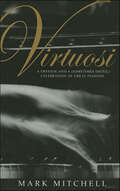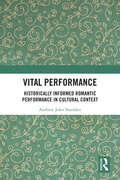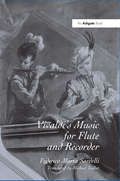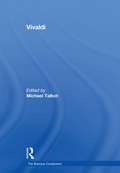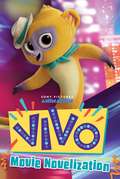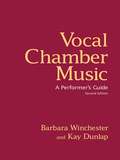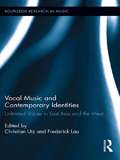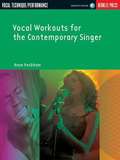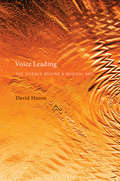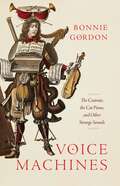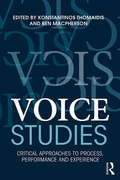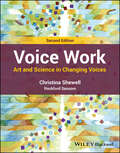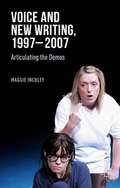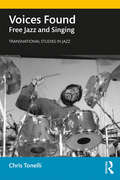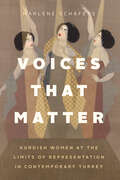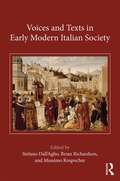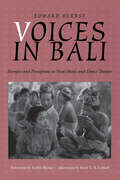- Table View
- List View
Virtuosi: A Defense and a (Sometimes Erotic) Celebration of Great Pianists
by Mark MitchellVirtuosiA Defense and a (Sometimes Erotic) Celebration of Great PianistsMark MitchellA bravura performance!"Vigorous, opinionated, and always entertaining, here is a personal essayist of great charm and sincerity. Mitchell's erudition—his collection of odd and illuminating bits of knowledge—is always a delight and adds a sauce piquanteto the whole dish!" —Edmund White"...a literary work of real élan, vibrancy, and grace—the very qualities that in his view define the virtuoso. [Mr. Mitchell explores] the traditional linking of musical and sexual virtuosity, the ethical implications of the original instruments' movement, the near deification of Mozart in Anglo-Saxon culture, and, in a particularly witty section, the relationship of the virtuoso to his stool. Throughout, Mr. Mitchell's prose is humorous, intimate, and unapologeticaly polemical." —Cynthia OzickThe artistic merit of performers with superior technique has long been almost ipso facto denied. At last, Mark Mitchell launches a counterattack. In essays crackling with pianistic lore, Mitchell takes on topics such as encores, prodigies, competitions, virtuosi in film and literature, and the erotics of musical performance. Liszt, Horowitz, and Argerich share these pages with the eccentric Pachmann, Ervin Nyiregyh ("the skid-row pianist"), and Liberace. The illustrations include rare portraits of long-forgotten girl prodigies, historic concert programs, and stills from a lost 1927 film on Beethoven. Punctuating this celebration of personal voice are vignettes, running from the beginnings of the author's obsession with the piano to the particularities of concert-going in Italy (where he now lives).Mark Mitchell's piano studies led to a friendship with Vladimir Horowitz and other pianistic luminaries. With David Leavitt he co-authored Italian Pleasures and co-edited Pages Passed from Hand to Hand. He also edited The Penguin Book of International Gay Writing.
Virtuosity
by Jessica MartinezAn intensely romantic, “brilliant debut” (Kirkus Reviews) about a dangerous addiction, a fierce rivalry, and a forbidden love.Now is not the time for Carmen to fall in love. And Jeremy is hands-down the wrong guy for her to fall for. He is infuriating, arrogant, and the only person who can stand in the way of Carmen getting the one thing she wants most: to win the prestigious Guarneri competition. Carmen’s whole life is violin, and until she met Jeremy, her whole focus was winning. But what if Jeremy isn’t just hot…what if Jeremy is better?Carmen knows that kissing Jeremy can’t end well, but she just can't stay away. Nobody else understands her—and riles her up—like he does. Still, she can’t trust him with her biggest secret: She is so desperate to win, she takes antianxiety drugs to perform, and what started as an easy fix has become a hungry addiction. Carmen is sick of not feeling anything on stage and even sicker of always doing what she’s told, doing what’s expected.Sometimes being on top just means you have a long way to fall….
Virtuosity
by Jessica MartinezAn intensely romantic, “brilliant debut” (Kirkus Reviews) about a dangerous addiction, a fierce rivalry, and a forbidden love.Now is not the time for Carmen to fall in love. And Jeremy is hands-down the wrong guy for her to fall for. He is infuriating, arrogant, and the only person who can stand in the way of Carmen getting the one thing she wants most: to win the prestigious Guarneri competition. Carmen’s whole life is violin, and until she met Jeremy, her whole focus was winning. But what if Jeremy isn’t just hot…what if Jeremy is better?Carmen knows that kissing Jeremy can’t end well, but she just can't stay away. Nobody else understands her—and riles her up—like he does. Still, she can’t trust him with her biggest secret: She is so desperate to win, she takes antianxiety drugs to perform, and what started as an easy fix has become a hungry addiction. Carmen is sick of not feeling anything on stage and even sicker of always doing what she’s told, doing what’s expected.Sometimes being on top just means you have a long way to fall….
Visualizing Music
by Eric IsaacsonTo feel the emotional force of music, we experience it aurally. But how can we convey musical understanding visually?Visualizing Music explores the art of communicating about music through images. Drawing on principles from the fields of vision science and information visualization, Eric Isaacson describes how graphical images can help us understand music. By explaining the history of music visualizations through the lens of human perception and cognition, Isaacson offers a guide to understanding what makes musical images effective or ineffective and provides readers with extensive principles and strategies to create excellent images of their own. Illustrated with over 300 diagrams from both historical and modern sources, including examples and theories from Western art music, world music, and jazz, folk, and popular music, Visualizing Music explores the decisions made around image creation. Together with an extensive online supplement and dozens of redrawings that show the impact of effective techniques, Visualizing Music is a captivating guide to thinking differently about design that will help music scholars better understand the power of musical images, thereby shifting the ephemeral to material.
Visualizing The Beatles: A Complete Graphic History of the World's Favorite Band
by Rob Thomas John PringForeword by Rob SheffieldFilled with stunning full-color infographics, a unique, album-by-album visual history of the evolution of the Beatles that examines how their style, their sound, their instruments, their songs, their tours, and the world they inhabited transformed over the course of a decade.Combining data, colorful artwork, interactive charts, graphs, and timelines, Visualizing the Beatles is a fresh and imaginative look at the world’s most popular band. Meticulously examining the songs on every Beatles’ album from Please Please Me to Let It Be, UK-based graphic artists John Pring and Rob Thomas deconstruct:lyrical contentsongwriting creditsinspiration for the songsinstruments usedcover designschart positionand more . . . .They also break down the success of Beatles’ singles across the world, their tour dates, venues, and cities, their hairstyles, fashion choices and favorite guitars, and a wealth of other Beatles’ minutiae. Visualizing the Beatles also includes illustrations involving the conspiracy theories of the "Paul is dead" hoax as well as A-to-Z lists of every artist or performer who has ever covered a Beatles’ song.Comprehensive, entertaining, and packed with fun facts, Visualizing the Beatles is a wonderful introduction for new fans and a must-have for devotees, offering a new way to think about this extraordinary band whose influence continues to shape music.
Vital Performance: Historically Informed Romantic Performance in Cultural Context
by Andrew SneddenHistorically Informed Performance, or HIP, has become an influential and exciting development for scholars, musicians, and audiences alike. Yet it has not been unchallenged, with debate over the desirability of its central goals and the accuracy of its results. The author suggests ways out of this impasse in Romantic performance style. In this wide-ranging study, pianist and scholar Andrew John Snedden takes a step back, examining the strengths and limitations of HIP. He proposes that many problems are avoided when performance styles are understood as expressions of their cultural era rather than as simply composer intention, explaining not merely how we play, but why we play the way we do, and why the nineteenth century Romantics played very differently. Snedden examines the principal evidence we have for Romantic performance style, especially in translation of score indications and analysis of early recordings, finally focusing on the performance styles of Liszt and Chopin. He concludes with a call for the reanimation of culturally appropriate performance styles in Romantic repertoire. This study will be of great interest to scholars, performers, and students, to anyone wondering about how our performances reflect our culture, and about how the Romantics played their own culturally-embedded music.
Vivaldi's Music for Flute and Recorder
by Michael TalbotFederico Maria Sardelli writes from the perspective of a professional baroque flautist and recorder-player, as well as from that of an experienced and committed scholar, in order to shed light on the bewildering array of sizes and tunings of the recorder and transverse flute families as they relate to Antonio Vivaldi's compositions. Sardelli draws copiously on primary documents to analyse and place in context the capable and surprisingly progressive instrumental technique displayed in Vivaldi's music. The book includes a discussion of the much-disputed chronology of Vivaldi's works, drawing on both internal and external evidence. Each known piece by him in which the flute or the recorder appears is evaluated fully from historical, biographical, technical and aesthetic standpoints. This book is designed to appeal not only to Vivaldi scholars and lovers of the composer's music, but also to players of the two instruments, students of organology and those with an interest in late baroque music in general. Vivaldi is a composer who constantly springs surprises as, even today, new pieces are discovered or old ones reinterpreted. Much has happened since Sardelli's book was first published in Italian, and this new English version takes full account of all these new discoveries and developments. The reader will be left with a much fuller picture of the composer and his times, and the knowledge and insights gained from minutely examining his music for these two wind instruments will be found to have a wider relevance for his work as a whole. Generous music examples and illustrations bring the book's arguments to life.
Vivaldi: The Manchester Violin Sonatas (The\baroque Composers Ser. #Vol. 47)
by Michael TalbotSince 1978, the 300th anniversary of Vivaldi's death, there has been an explosion of serious writing about his music, life and times. Much of this has taken the form of articles published in academic journals or conference proceedings, some of which are not easy to obtain. The twenty-two articles selected by Michael Talbot for this volume form a representative selection of the best writing on Vivaldi from the last 30 years, featuring such major figures in Vivaldi research as Reinhard Strohm, Paul Everett, Gastone Vio and Federico Maria Sardelli. Aspects covered include biography, Venetian cultural history, manuscript studies, genre studies and musical analysis. The intention is to serve as a 'first port of call' for those wishing to learn more about Vivaldi or to refresh their existing knowledge. An introduction by Michael Talbot reviews the state of Vivaldi scholarship past and present and comments on the significance of the articles.
Vivo Movie Novelization (Vivo)
by Ximena HastingsVivo, the highly anticipated animated movie-musical with original songs by Lin-Manuel Miranda, will soon be dancing onto Netflix! This funny and heartfelt novelization features eight pages of images from the film and is sure to have readers singing and laughing along!Meet Vivo and experience his passion for music. Join him as he travels from Havana to Miami on a musical journey. TM & © 2021 Sony Pictures Animation Inc. All Rights Reserved.
Vocal Chamber Music: A Performer's Guide
by Barbara Winchester Kay DunlapThis invaluable resource is a revised edition of an essential index to vocal works composed for at least one solo voice and one instrument (other than piano or guitar) up to twelve solo voices and twelve solo instruments. The book includes a brief introduction on how to teach vocal chamber music, with tips on running a successful ensemble. Vocal Chamber Music: A Performer's Guide, 2nd Edition is a much needed and important book for voice teachers, singers, music directors and music libraries, for information that is normally difficult to find and usually requires assembling from various sources.
Vocal Music and Contemporary Identities: Unlimited Voices in East Asia and the West (Routledge Research in Music #3)
by Christian Utz Frederick LauLooking at musical globalization and vocal music, this collection of essays studies the complex relationship between the human voice and cultural identity in 20th- and 21st-century music in both East Asian and Western music. The authors approach musical meaning in specific case studies against the background of general trends of cultural globalization and the construction/deconstruction of identity produced by human (and artificial) voices. The essays proceed from different angles, notably sociocultural and historical contexts, philosophical and literary aesthetics, vocal technique, analysis of vocal microstructures, text/phonetics-music-relationships, historical vocal sources or models for contemporary art and pop music, and areas of conflict between vocalization, "ethnicity," and cultural identity. They pinpoint crucial topical features that have shaped identity-discourses in art and popular musical situations since the1950s, with a special focus on the past two decades. The volume thus offers a unique compilation of texts on the human voice in a period of heightened cultural globalization by utilizing systematic methodological research and firsthand accounts on compositional practice by current Asian and Western authors.
Vocal Wisdom Maxims of Giovanni Battista Lamperti [1931 edition]
by Giovanni B. LampertiGiovanni Battista Lamperti (1839 -1910) was an Italian singing teacher and son of the singing teacher Francesco Lamperti. He is source for Vocal Wisdom: Maxims of Giovanni Battista Lamperti (1931). His preferred teaching arrangement was having three or four students present at each lesson: each would get their turn while the others observed and learned thereby. He was said to be a strict, exacting instructor not given to flattery, but who enthusiastically praised his students upon exceptional achievement. Many of Giovanni's students became international opera stars including Irene Abendroth, Marcella Sembrich, Ernestine Schumann-Heink, Paul Bulss, Roberto Stagno, David Bispham and Franz Nachbaur. The Technics of Bel Canto is the only book (other than the maxims recalled and published posthumously by his pupil William E. Brown) that Giovanni ever wrote on his method.-Print ed.
Vocal Workouts for the Contemporary Singer
by Anne PeckhamThis Book is for singers who are interested in contemporary, non-classical singing styles. It is a look at breath support, tone production, and voice strengthening, plus material for more experienced singers who want to continue to develop their voices. By following the Complete Vocal Workouts presented in this book, you will be able to sing with improved range, agility, sound, and overall expressive power.
Voice Leading: The Science behind a Musical Art
by David HuronVoice leading is the musical art of combining sounds over time. In this book, David Huron offers an accessible account of the cognitive and perceptual foundations for this practice. Drawing on decades of scientific research, including his own award-winning work, Huron offers explanations for many practices and phenomena, including the perceptual dominance of the highest voice, chordal-tone doubling, direct octaves, embellishing tones, and the musical feeling of sounds "leading" somewhere. Huron shows how traditional rules of voice leading align almost perfectly with modern scientific accounts of auditory perception. He also reviews pertinent research establishing the role of learning and enculturation in auditory and musical perception.Voice leading has long been taught with reference to Baroque chorale-style part-writing, yet there exist many more musical styles and practices. The traditional emphasis on Baroque part-writing understandably leaves many musicians wondering why they are taught such an archaic and narrow practice in an age of stylistic diversity. Huron explains how and why Baroque voice leading continues to warrant its central pedagogical status. Expanding beyond choral-style writing, Huron shows how established perceptual principles can be used to compose, analyze, and critically understand any kind of acoustical texture from tune-and-accompaniment songs and symphonic orchestration to jazz combo arranging and abstract electroacoustic music. Finally, he offers a psychological explanation for why certain kinds of musical textures are more likely to be experienced by listeners as pleasing.
Voice Leading: The Science behind a Musical Art (The\mit Press Ser.)
by David HuronAn accessible scientific explanation for the traditional rules of voice leading, including an account of why listeners find some musical textures more pleasing than others.Voice leading is the musical art of combining sounds over time. In this book, David Huron offers an accessible account of the cognitive and perceptual foundations for this practice. Drawing on decades of scientific research, including his own award-winning work, Huron offers explanations for many practices and phenomena, including the perceptual dominance of the highest voice, chordal-tone doubling, direct octaves, embellishing tones, and the musical feeling of sounds “leading” somewhere. Huron shows how traditional rules of voice leading align almost perfectly with modern scientific accounts of auditory perception. He also reviews pertinent research establishing the role of learning and enculturation in auditory and musical perception.Voice leading has long been taught with reference to Baroque chorale-style part-writing, yet there exist many more musical styles and practices. The traditional emphasis on Baroque part-writing understandably leaves many musicians wondering why they are taught such an archaic and narrow practice in an age of stylistic diversity. Huron explains how and why Baroque voice leading continues to warrant its central pedagogical status. Expanding beyond choral-style writing, Huron shows how established perceptual principles can be used to compose, analyze, and critically understand any kind of acoustical texture from tune-and-accompaniment songs and symphonic orchestration to jazz combo arranging and abstract electroacoustic music. Finally, he offers a psychological explanation for why certain kinds of musical textures are more likely to be experienced by listeners as pleasing.
Voice Machines: The Castrato, the Cat Piano, and Other Strange Sounds
by Bonnie GordonAn exploration of the castrato as a critical provocation to explore the relationships between sound, music, voice instrument, and machine. Italian courts and churches began employing castrato singers in the late sixteenth century. By the eighteenth century, the singers occupied a celebrity status on the operatic stage. Constructed through surgical alteration and further modified by rigorous training, castrati inhabited human bodies that had been “mechanized” to produce sounds in ways that unmechanized bodies could not. The voices of these technologically enhanced singers, with their unique timbre, range, and strength, contributed to a dramatic expansion of musical vocabulary and prompted new ways of imagining sound, the body, and personhood. Connecting sometimes bizarre snippets of history, this multi-disciplinary book moves backward and forward in time, deliberately troubling the meaning of concepts like “technology” and “human.” Voice Machines attends to the ways that early modern encounters and inventions—including settler colonialism, emergent racialized worldviews, the printing press, gunpowder, and the telescope—participated in making castrati. In Bonnie Gordon’s revealing study, castrati serve as a critical provocation to ask questions about the voice, the limits of the body, and the stories historians tell.
Voice Studies: Critical Approaches to Process, Performance and Experience (Routledge Voice Studies)
by Konstantinos Thomaidis Ben MacphersonVoice Studies brings together leading international scholars and practitioners, to re-examine what voice is, what voice does, and what we mean by "voice studies" in the process and experience of performance. This dynamic and interdisciplinary publication draws on a broad range of approaches, from composing and voice teaching through to psychoanalysis and philosophy, including: voice training from the Alexander Technique to practice-as-research; operatic and extended voices in early baroque and contemporary underwater singing; voices across cultures, from site-specific choral performance in Kentish mines and Australian sound art, to the laments of Kraho Indians, Korean pansori and Javanese wayang; voice, embodiment and gender in Robertson’s 1798 production of Phantasmagoria, Cathy Berberian radio show, and Romeo Castellucci’s theatre; perceiving voice as a composer, listener, or as eavesdropper; voice, technology and mobile apps. With contributions spanning six continents, the volume considers the processes of teaching or writing for voice, the performance of voice in theatre, live art, music, and on recordings, and the experience of voice in acoustic perception and research. It concludes with a multifaceted series of short provocations that simply revisit the core question of the whole volume: what is voice studies?
Voice Work: Art and Science in Changing Voices
by Christina Shewell Rockford SansomVoice Work Second Edition The voice is one of the fundamental modes of self-expression, a key touchstone of identity and sense of self. Many people in all walks of life are looking to change their voices, whether to modify a speaking challenge of some kind, to cultivate a professional skill, or for other reasons. Voice practitioners have an invaluable role in guiding clients along the path to their desired voice outcomes. Building on the success of the first edition, Voice Work continues to offer a wide-ranging introduction to the repair, improvement, development, and exploration of the spoken and sung voice. Balancing rigorous scholarship with practical insights, the book draws from all major vocal professions and paths within voice work. It offers guidance for developing the voice alongside detailed, up-to-date insights into the work of voice instruction. Readers of the second edition of Voice Work will also find: Numerous new colour illustrationsExtensive chapter revisions and reference updatesOriginal chapters on the history of voice work, public speaking and voice work onlineUpdated material on voice and emotions, mindfulness and imagery, voice work and well-being, the applications of technology and the value of practitioner supervisionAdditional techniques and exercises Voice Work is a valuable resource for spoken voice teachers, singing teachers, and speech and language therapists and pathologists. Endorsements from leading members of these professions for both the first and second editions are featured inside.
Voice and New Writing, 1997–2007
by Maggie InchleyVoice and New Writing, 1997–2007 uses the voice as a focus for critical enquiry. It explores new writing theatres' claims to 'find' and to represent previously marginalised voices during Tony Blair's decade as Prime Minister. Hearing 'cultural evidence' for what Raymond Williams termed 'structures of feeling' in the articulation of identities, Maggie Inchley attends to the negotiation of accepted etiquettes of articulation and audibility through processes used in writing, voice training and performance. In the voices of theatre this book hears the narrative of betrayal around Anthony Giddens' 'promise of democracy', and an embattled belief in both transparency and dialogue as necessary conditions of representation. Voice and New Writing, 1997 – 2007 explores the use of voices in the work of writers including debbie tucker green, Gregory Burke, Kwame Kwei-Armah, Enda Walsh, Mark Ravenhill, and Dennis Kelly, as well as exploring the influential practice of voice teachers Cicely Berry, Patsy Rodenburg, Kristin Linklater and others.
Voices Found: Free Jazz and Singing
by Chris TonelliVoices Found: Free Jazz and Singing contributes to a wave of voice studies scholarship with the first book-length study of free jazz voice. It pieces together a history of free jazz voice that spans from sound poetry and scat in the 1950s to the more recent wave of free jazz choirs. The author traces the developments and offers a theory, derived from interviews with many of the most important singers in the history of free jazz voice, of how listeners have experienced and evaluated the often unconventional vocal sounds these vocalists employed. This theory explains that even audiences willing to enjoy harsh sounds from saxophones or guitars often resist when voices make sounds that audiences understand as not-human. Experimental poetry and scat were combined and transformed in free jazz spaces in the 1960s and 1970s by vocalists like Yoko Ono (in solo work and her work with Ornette Coleman and John Stevens), Jeanne Lee (in her solo work and her work with Archie Shepp and Gunter Hampel), Leon Thomas (in his solo work as well as his work with Pharoah Sanders and Carlos Santana), and Phil Minton and Maggie Nicols (who devoted much of their energy to creating unaccompanied free jazz vocal music). By studying free jazz voice we can learn important lessons about what we expect from the voice and what happens when those expectations are violated. This book doesn't only trace histories of free jazz voice, it makes an attempt to understand why this story hasn't been told before, with an impressive breadth of scope in terms of the artists covered, drawing on research from the US, Canada, Wales, Scotland, France, The Netherlands, and Japan.
Voices That Matter: Kurdish Women at the Limits of Representation in Contemporary Turkey
by Marlene SchäfersA fine-grained ethnography exploring the sociopolitical power of Kurdish women’s voices in contemporary Turkey. “Raise your voice!” and “Speak up!” are familiar refrains that assume, all too easily, that gaining voice will lead to empowerment, healing, and inclusion for marginalized subjects. Marlene Schäfers’s Voices That Matter reveals where such assumptions fall short, demonstrating that “raising one’s voice” is no straightforward path to emancipation but fraught with anxieties, dilemmas, and contradictions. In its attention to the voice as form, this book examines not only what voices say but also how they do so, focusing on Kurdish contexts where oral genres have a long, rich legacy. Examining the social labor that voices carry out as they sound, speak, and resonate, Schäfers shows that where new vocal practices arise, they produce new selves and practices of social relations. In Turkey, recent decades have seen Kurdish voices gain increasing moral and political value as metaphors of representation and resistance. Women’s voices, in particular, are understood as potent means to withstand patriarchal restrictions and political oppression. By ethnographically tracing the transformations in how Kurdish women relate to and employ their voices as a result of these shifts, Schäfers illustrates how contemporary politics foster not only new hopes and desires but also create novel vulnerabilities as they valorize, elicit, and discipline voice in the name of empowerment and liberation.
Voices That Matter: Kurdish Women at the Limits of Representation in Contemporary Turkey
by Marlene SchäfersA fine-grained ethnography exploring the sociopolitical power of Kurdish women’s voices in contemporary Turkey. “Raise your voice!” and “Speak up!” are familiar refrains that assume, all too easily, that gaining voice will lead to empowerment, healing, and inclusion for marginalized subjects. Marlene Schäfers’s Voices That Matter reveals where such assumptions fall short, demonstrating that “raising one’s voice” is no straightforward path to emancipation but fraught with anxieties, dilemmas, and contradictions. In its attention to the voice as form, this book examines not only what voices say but also how they do so, focusing on Kurdish contexts where oral genres have a long, rich legacy. Examining the social labor that voices carry out as they sound, speak, and resonate, Schäfers shows that where new vocal practices arise, they produce new selves and practices of social relations. In Turkey, recent decades have seen Kurdish voices gain increasing moral and political value as metaphors of representation and resistance. Women’s voices, in particular, are understood as potent means to withstand patriarchal restrictions and political oppression. By ethnographically tracing the transformations in how Kurdish women relate to and employ their voices as a result of these shifts, Schäfers illustrates how contemporary politics foster not only new hopes and desires but also create novel vulnerabilities as they valorize, elicit, and discipline voice in the name of empowerment and liberation.
Voices That Matter: Kurdish Women at the Limits of Representation in Contemporary Turkey (Mersion: Emergent Village Resources For Communities Of Faith Ser.)
by Marlene SchäfersA fine-grained ethnography exploring the sociopolitical power of Kurdish women’s voices in contemporary Turkey. “Raise your voice!” and “Speak up!” are familiar refrains that assume, all too easily, that gaining voice will lead to empowerment, healing, and inclusion for marginalized subjects. Marlene Schäfers’s Voices That Matter reveals where such assumptions fall short, demonstrating that “raising one’s voice” is no straightforward path to emancipation but fraught with anxieties, dilemmas, and contradictions. In its attention to the voice as form, this book examines not only what voices say but also how they do so, focusing on Kurdish contexts where oral genres have a long, rich legacy. Examining the social labor that voices carry out as they sound, speak, and resonate, Schäfers shows that where new vocal practices arise, they produce new selves and practices of social relations. In Turkey, recent decades have seen Kurdish voices gain increasing moral and political value as metaphors of representation and resistance. Women’s voices, in particular, are understood as potent means to withstand patriarchal restrictions and political oppression. By ethnographically tracing the transformations in how Kurdish women relate to and employ their voices as a result of these shifts, Schäfers illustrates how contemporary politics foster not only new hopes and desires but also create novel vulnerabilities as they valorize, elicit, and discipline voice in the name of empowerment and liberation.
Voices and Texts in Early Modern Italian Society
by Brian Richardson Massimo Rospocher Stefano Dall’AglioThis book studies the uses of orality in Italian society, across all classes, from the fifteenth to the seventeenth century, with an emphasis on the interrelationships between oral communication and the written word. The Introduction provides an overview of the topic as a whole and links the chapters together. Part 1 concerns public life in the states of northern, central, and southern Italy. The chapters examine a range of performances that used the spoken word or song: concerted shouts that expressed the feelings of the lower classes and were then recorded in writing; the proclamation of state policy by town criers; songs that gave news of executions; the exercise of power relations in society as recorded in trial records; and diplomatic orations and interactions. Part 2 centres on private entertainments. It considers the practices of the performance of poetry sung in social gatherings and on stage with and without improvisation; the extent to which lyric poets anticipated the singing of their verse and collaborated with composers; performances of comedies given as dinner entertainments for the governing body of republican Florence; and a reading of a prose work in a house in Venice, subsequently made famous through a printed account. Part 3 concerns collective religious practices. Its chapters study sermons in their own right and in relation to written texts, the battle to control spaces for public performance by civic and religious authorities, and singing texts in sacred spaces.
Voices in Bali: Energies and Perceptions in Vocal Music and Dance Theater (Music Culture)
by Rene T. Lysloff Edward Herbst Judith BeckerA scholar and trained performer of Balinese vocal music and dance, ethnomusicologist Edward Herbst brings unique talents to bear in this provocative book. The lessons of his Balinese masters enable him to offer fresh insight to this culture's aesthetics and cultural elements. Appropriating John Cage's effective style of "mixing theory, anecdote, context, philosophy, and humor," Herbst crafts an accessible body of work, compelling in substance and form. By merging the "Balinese concept of place-time-context with Cage's concepts of structure, method, and form, [Herbst] returns to the critical issue of what scholars and intercultural artists are doing, and 'what' is their 'object' under study." Undergraduates and scholars in fields as varied as theater studies and anthropology will find this book and companion CD (in print editions) an important resource not only for its knowledgeable treatment of Balinese culture, but as an example of a more personal and engaging style of scholarly discourse. The ebook edition includes embedded audio.
